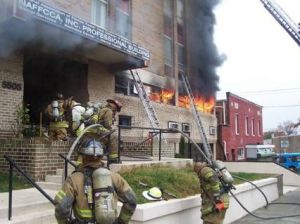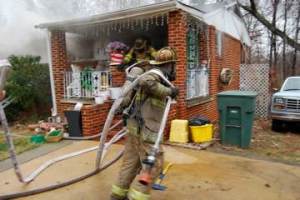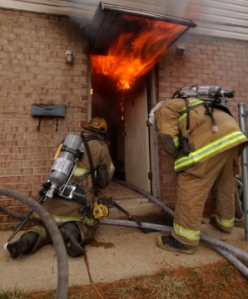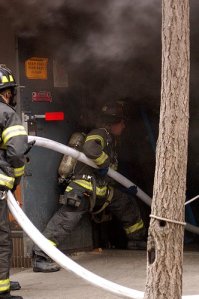Tim Linke from Lincoln, NE sent me this basic but thought provoking inquiry. We all talk about being "combat ready". Weather you use that particular term or not, if you're reading this you're probably interested in being your best, A+ performances all the time, etc...
So for those of us in an engine company - WHAT IS COMBAT READY?



This is quite an extensive topic, so here are a few of my first thoughts. I'm sure this will lead to a few more posts expanding on these thoughts, and hopefully some comments from everyone else on what they think a "combat ready" crew should focus on.
First - EVERY ALARM IS THE "FIRE OF YOUR CAREER" UNTIL YOU PROVE OTHERWISE, ACT ACCORDINGLY. There are babies trapped, everyone's counting on you, you're actions will make or break this fire. If you take every action with these thoughts in mind, it doesn't matter if they're true or not - you'll be performing at your best.
A quality engine is nothing without a quality crew. It seems like an obvious statement, but the rig doesn't put out the fire - you do. So what are the essential skills for an engine crew? Come off dressed, with firefighting gloves on. I see guys getting off with no gloves, leather gloves, or rescue gloves. What are you going to do with that? Any fire worth anything is going to burn the hell out of you if you're not wearing the correct gloves. Oh, you'll put them on when it's time? As stupid as it sounds - putting a pair of gloves on can take up to 30 seconds. Try telling the father in the front yard who's screaming about his trapped kids to "hang on a sec"... You had that whole response time to get dressed, NOW is not the time for it.
In my opninon, when you come off the rig it is TIME TO WORK. Your hands will be pulling line, maybe forcing a door, whatever. If you rip you fingernail off, cut your wrist, or break your finger because you didn't have gloves on, YOU ARE OUT OF THE GAME.

Nobody wants to wait for you. Be ready!
Oh you can't work well in your gloves? Poor dexterity? SUCK IT UP. Practice. Get different gloves. Soak your gloves and let them dry on your hands. Whatever you need to do - it is not impossible to mask up, tie nots, or do anything else wearing firefighting gloves. If you can't, its because you haven't tried/practiced hard enough.
Mask up at the fire entrance quickly. I am NOT a fan of coming off the rig with your face piece on. After my tirade about gloves, you may wonder why. When you're stretching lines, you need to be able to see where you are going. At night, in poor weather, or when stretching over long distances the face mask reduces your vision - even more so if it starts fogging up. You may not know the obstacles you'll encounter during your stretch until you encounter them, so you need to be able to see.

When we encounter smoke, it's time to mask up. A "combat ready" crew should be able to do this in under 30 seconds.

The firefighter in that video is a probationer with about 5 months in the fire service, no prior experience, no other training than the academy. After about 10 minutes of mentoring, as you can see, he can go from dressed to masked-up in about 15 seconds. Trust me, if HE can do it - so can YOU... PRACTICE.
Setup the rig for your first due. Your engine should be setup to reflect your typical manpower and the buildings & challenges in your first due area. Many departments operate with the same setup they had 50 years ago, "just because", or emulate the setups of other fire departments. Borrowing ideas from other places is great - IF THAT IDEA FITS YOUR FIRST-DUE. But if you're running a pumper/tanker setup in an area with McMansions, what a FDNY engine in the Bronx has on it is probably irrelevant to you.
Attack lines should be quick/easy to pull and VERSATILE. Attack lines should ideally be at shoulder height on the rig. I shouldn't have to climb a ladder to pull a crosslay. We should know how to use the limited lines we have to accomplish multiple evolutions such as extending lines, covering long distances, well stretches, window stretches, etc...
Establish a water supply every time. If you're responding to a reported structural fire, PUT HOSE BETWEEN YOUR WATER SUPPLY & YOUR RIG EVERYTIME. "Nothing showing" means nothing. That big 8-alarm fire we had in DC last march started out as "nothing showing". You & me both have seen plenty of places BURN DOWN due to water supply issues. If you run out of water, GAME OVER. If you got dispatched to a reported fire and didn't take steps to establish a continuous water supply, sad to say, IT'S YOUR FAULT.
If it's an interior attack, it's an AGRESSIVE interior attack. There are two options in interior firefighting: winning & losing. There is no such thing as "holding it". When you open the line, work the ceiling, work the walls, sweep the floor, and MOVE IN - repeat. If you're not moving, you're losing.
Back-up firefighters make or break the operation. The nozzleman is the glory-guy, but he's basically got the easiest job. If the back-up FF's don't feed the line and move it around obstacles, the nozzleman get's nowhere and the company fails as a whole.

The nozzle FF only has fun because the backup FF GETS HIM TO THE FIRE.
These are just a VERY FEW of my first thoughts regarding a combat ready engine company. What are yours?
Happy Holidays,
-Nick
Views: 930
Comment
-
Comment by Nick Martin on November 22, 2011 at 4:07pm
-
Absolutely Chief, agree with your comments totally, particularly door control. That is something we preach during forcible entry training quite a bit but it also deserves mention here. It shouldn't open or close unless you want it to! I also share the same observations about gloves. Maybe it's harsh - but as I said above:
"Oh you can't work well in your gloves? Poor dexterity? SUCK IT UP. Practice. Get different gloves. Soak your gloves and let them dry on your hands. Whatever you need to do - it is not impossible to mask up, tie nots, or do anything else wearing firefighting gloves. If you can't, its because you haven't tried/practiced hard enough."
© 2024 Created by fireeng.
Powered by
![]()

You need to be a member of Fire Engineering Training Community to add comments!
Join Fire Engineering Training Community